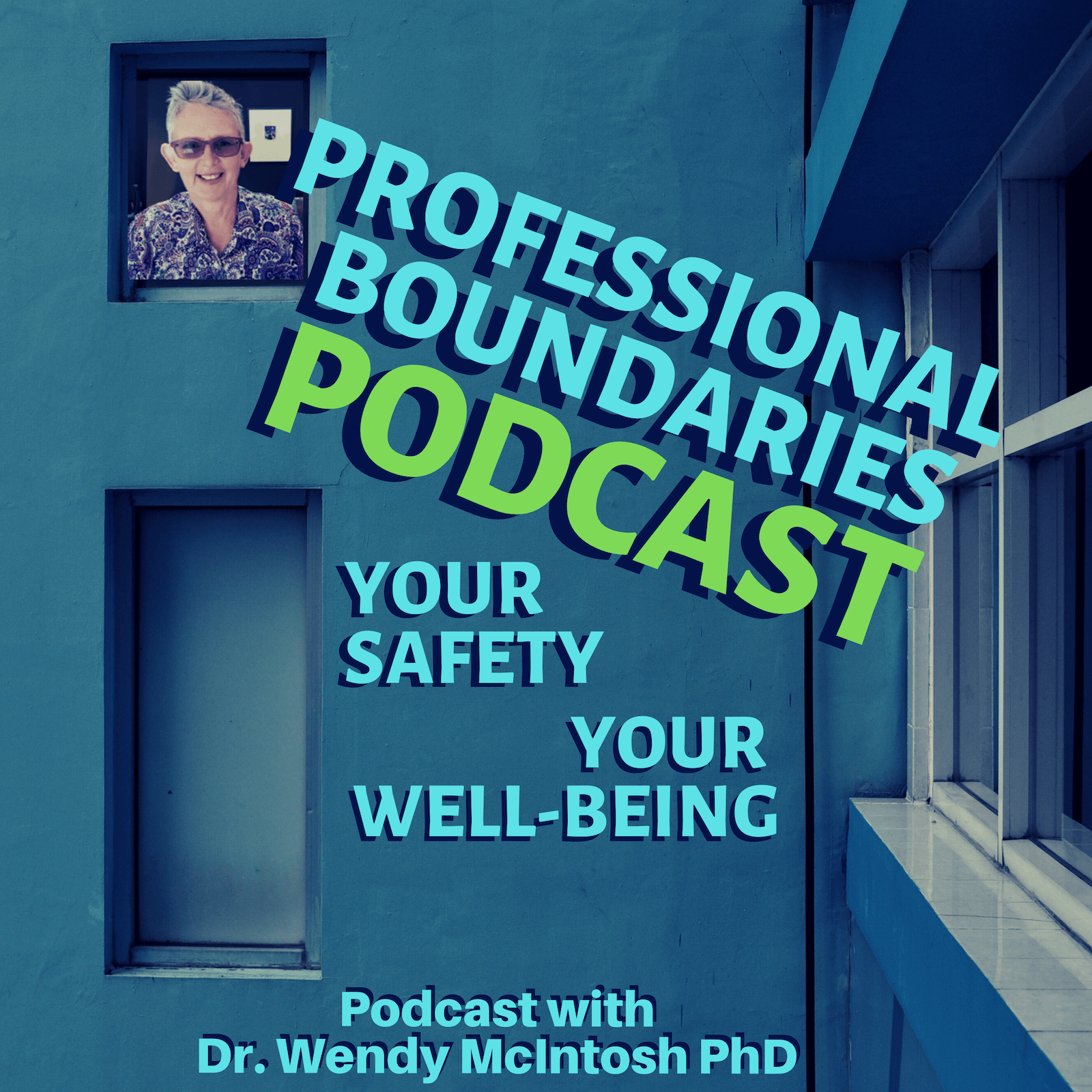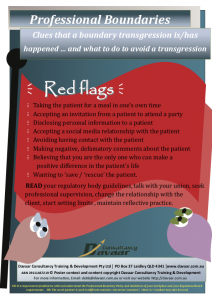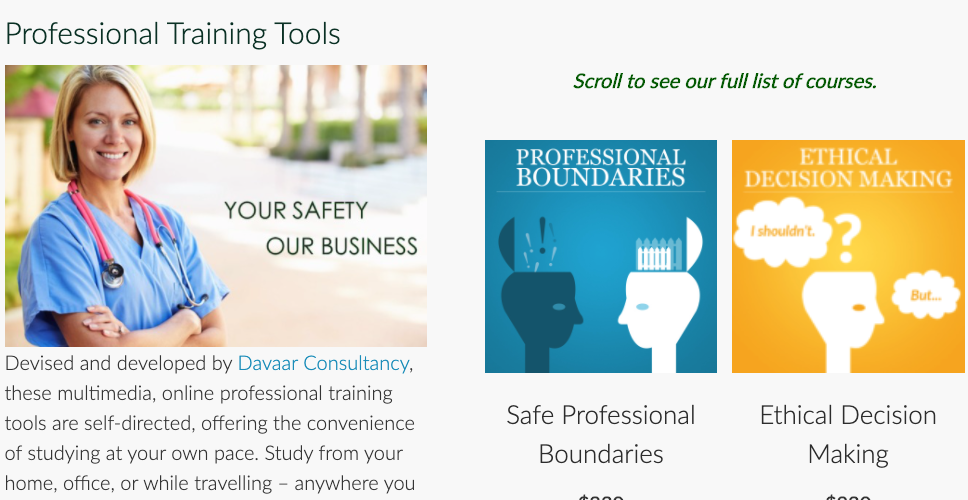Podcast: Play in new window | Download (Duration: 39:29 — 26.4MB)
Subscribe: Apple Podcasts | Spotify | TuneIn
Episode 4 – Those Red Flags – What are they and do I really want to listen to them?

In Episode 4, Dr Wendy McIntosh PhD, from Davaar Consultancy shares another potential Professional boundary transgression scenario, the red flags that were apparent, and how responding to those red flags in a different way could have prevented a challenging situation for a male teacher.
In this episode, Dr Wendy discusses what the alerts that we call Red Flags might look and feel like, in more detail and some clever ways to respond to them. 
This is the fourth part of a dialogue that be will be continued in the following episodes. Use the links above to subscribe, or click the play button to listen.
Listen to Episode 5 here.
There are 6 episodes planned in this first season of the Professional Boundaries Podcast and we hope you’ll be back to enjoy and learn from each of them. If you’ve ever wondered about your own boundaries in your Professional role, or been alerted about the risks of crossings or violations, this podcast will help you learn what to watch for, and ways to stay out the danger zones.
Dr. Wendy McIntosh welcomes both your interest and curiosity. Send Wendy questions at wendy@davaar.com.au or via Twitter, Instagram or Linked In

Dr. Wendy McIntosh PhD
Since 2005 Wendy has been developing her knowledge and interest in the area of professional boundaries. Wendy delivers workshops on boundaries in Australia (where she now lives) and Internationally when invited to do so. She is continually integrating learning and insights she gains from the work she does in professional boundaries. Wendy comes from a nursing, and predominately psychiatric nursing, background.
Wendy consistently receives feedback on her passion, knowledge, and creativity as a presenter and facilitator. Enjoy exploring boundaries in this podcast series as Wendy takes you on your own reflective journey on your professional boundaries.
References:
References
Collins Dictionary accessed at: https://www.collinsdictionary.com/dictionary/english/intuition
Instagram post- https://www.instagram.com/p/B5d2GvqDiH9/ McIntosh, W.H. (2019).
Music clips in this podcast:
“Horizon Flare” by Alexander Nakarada (Found at http://FreePD.com Artist- https://alexandernakarada.bandcamp.com) &
“Inspiration ” by Rafael Kruz ((Found at http://FreePD.com Artist- https://www.orchestralis.net/)
License: CC 0 BY (http://creativecommons.org/licenses/by/4.0/)
Transcript: Podcast Four – Those red flags – what are they and do I really want to listen to them?
“Notice the red flags in your body – they are there for you to be conscious of the relationship dynamics” (McIntosh 2019)
Scenario
He had been a secondary school teacher for 12 years and had always been careful to separate his professional life from his personal. No complaints had been made against him in that time. No colleagues or peers had approached him with concerns about how he interacted with the students.
One day his Principal approached him “…… I need to have a meeting with you about your conduct with one of the year 10 students”.
The Principal had received a complaint from the parent of a female student. The complaint was that the teacher had not been paying her the same amount of attention that she witnessed him give to other students, especially to other female students. The parent was concerned that perhaps the teacher was discriminating against her daughter for some reason.
Welcome to this Podcast series – Professional Boundaries, Your safety, your wellbeing.
I am Wendy Mcintosh from Davaar Consultancy and I am delighted that you are joining me on another journey into the world of professional boundaries. This podcast series invites you to reflect on your Professional Boundaries and to appreciate how knowing the five foundation stones of boundaries can assist you in the everyday work that you do. This is our fourth episode in a planned series of six podcasts and I stay open to producing more as required.
I would love to have your input through questions, scenarios to explore or reflections from each episode. One of my aims for these podcasts is to have you engaged in the process with me. I know from experience that having discussions about boundaries and what it means for us in the work and services we provide is an important step in assisting us to understand motivations for our actions. Contact details are provided at the end of this podcast.
I want to thank listeners who have already made contact with me through email. I am delighted with the positive responses coming back to us about our podcasts. I am equally delighted that team leaders from two organisations have said that they will be encouraging all their staff to listen in. This is what I wanted to create – a broader platform from which robust and reflective discussions about boundaries can occur. So thank you, keep your emails coming.
In today’s episode we explore foundation stone number three – red flags.
As I was writing this episode I had an image of the flags of countries being carried during the initial and final march of Olympians for the Olympic games. The flags are held high, they move with the movement of the holder, with the movement of the breeze, with the movement of energy in the excitement and trepidation of the occasion.
Similarly, the red flags of professional boundaries move in front of us alerting us that something is occurring in the relationship for us to pay attention to. The red flags are the alert systems of our intuition or of other people’s observations. The red flags wave to us saying – slow down, pause, take a breath, check-in. Check-in with yourself, check in with a colleague, check-in with the patient.
The waving of the flags asks us to pay attention to the intense emotional responses that we may have towards a patient. The movement of the flags invite us to take stock, to ask – what am I about to do here, whose needs are being met, what options do I have right now in terms of developing/sustaining a respectful boundary with this other person?
Conversely, rather than questions, we come up with red flag commentary, “ok that was not such a good thing to say”, oops I might have crossed the boundary there” “I will have to be more careful in future with this patient”.
There are several red flags that I will explore in this podcast. They include the red flags of:
- communication (verbal and nonverbal),
- taking work home
- experiences in the body – intuitive (internal) and actual movements (external)
- comments from clients, their family members, colleagues
I will begin by discussing the red flags of intuition and movement in/of our bodies
Intuition is defined in the Collins Dictionary as unexplained feelings that a person has that something is true even when there is no evidence or proof of it. Our intuitive messages will start as a whisper, a gentle teasing – then will grow in volume and movement if we continue to ignore, dispel or even argue against our knowing. Our intuitive alerts – you know the ones – rising hairs on the back of your neck, the swirling in your stomach. Other intuitive responses in our body include pressing fingers above our eyebrows, tightening of our jaws, neck pulling back, hand outstretches facing upwards, pulling on one of our earlobes, a feeling of sickness. It is as though our body is waving red flags that say – drawing back, keep quiet here, anchor yourself down.
These are the hunches, the gut feelings. Perhaps there are words that go along with the feeling such as “something is wrong here”, “this is very strange”, “this does not feel safe”. For me, intuition can invite us to waken up, to don that Sherlock Holmes curious inquirer hat. In boundary work, it is important to recognise the alert centres in our bodies and to listen in to the messages our bodies are giving us.
There are many participants whom I have worked within boundary training who learnt from an early age not to listen to their intuitive self. To quieten their intuitive alert system. For some, it was dangerous to share their experiences with others especially their caregivers. Individuals who had been told in childhood that “they got it wrong” that what they were feeling “was not true” have a greater struggle in their professional role when their intuitive alert system says “watch out here”.
For those individuals, the boundary work with themselves becomes the most integral work they do with me. Professional boundaries starts and ends with the individual, with I, with me. I in relationship to myself and with the other person. In order to effectively manage the boundary with the other person, I have to learn to manage the boundary with myself. I have to erase old teaching about not trusting myself and integrate into my being – I have to trust that my intuitive self is wise and knowing. To trust that I am enough.
I encourage participants to identify and seek out a colleague whom they assess holds their best interests at heart. I say to them – let that trusted other be your eyes and your curiosity until you have trained yourself to be your own best boundary awareness guide. Yes trained yourself. I absolutely believe that boundary work requires exquisite self-training. To notice what we notice. To take notice of what we notice. To be curious about what we notice. Those four boundary questions introduced in previous episodes begin that lovely and at times disturbing self-awareness exploration about self and boundaries.
What was/is the intent and purpose?
Whose needs were/are being met?
Was/are there other options available?
What stopped/stops me using other options?
Boundary training requires us to understand the motivations behind the actions that led to the transgression/s. It requires us to acknowledge old role responses in us – the scripts and behaviours from childhood, from our family, our tribe, our community, our land. To recognise their part in getting us to this place in life where we now find ourselves and to change what is required to keep us safe in our professional role. To maintain our well being.
I believe that boundary work requires us to notice the movement of our arms, our hands. Noticing the ways our bodies react to the invites or criticism of other people we are interacting with. The movement of our bodies becomes the red flags when we are aware of what the movements mean for and to us. The subtle and loud changes in our body that can lead to significant changes in a relationship. Changes that we might not take notice of and yet the client reads something different in the movement. Perhaps that subtle movement sets up a fantasy about possibilities in the relationship that the professional would never consider.
I reflect with participants about the movement in their body – the body moving to accept an invite, arms reaching out to initiate or reciprocate a hug – a movement that occurs before a thought enters consciousness. It is so important to recognise the movement in our body and to then create a pause and to allow questions to emerge internally – what am I doing here, what other options do I have?
I know from the work I do – that this taking stock, this having a pause, this creating space to let the question in, does require a retraining in our bodies.
Taking work home – red flag…..
It may be that the red flags will be more obvious to our patients, to our colleagues and peers than they are to us. Perhaps even our family members experience something in us that we are not so conscious of in ourselves. Those experiences that we take home and the ways in which our tone of voice, content of speech or emotional expression in our bodies change perhaps highlighting something different about this client that we have taken home (psychologically or emotionally). Sometimes it is the wiseness and naivety of our children that is a red flag for us. Like the child who speaks a truth about the lack of clothing on the emperor, our own child or children may speak out and say “mum, dad, why do you always talk about work, I want you to read a story to me, or “I had something important to tell you about school today, but you don’t seem to be listening”. Many participants have shared with me – that it is the statements from their children that is the loudspeaker to their own quietened intuitive voices.
The clarity of a child’s expression into the busyness of our working life can be very sobering. It could be that the truth-speaking red flag from our children resonates more with us than anything a colleague says to us. As I say to participants – when we are in the depth of a relationship with clients we might not always be aware of how our behaviours and speech content is perceived by others. It is not uncommon that someone else in our lives will notice the depth we are earlier than we do.
The child or other family member experiences the red flag of our distraction, of our concentration being elsewhere. They experience in the relationship with us at that moment that we are not actually present with them – we are in fact focused on that client at work. That focus could be intense feelings that we have about the client and or the system we work in – anger, rage, despair, frustration, love, loyalty, unfairness. In the bulge of emotions, it is more difficult for us to pause and to ask – what is going on for me here, what is happening for me in relationship to this client that I have taken them home with me. I have psychologically and emotionally taken them in through the front door of my home and sat them down in between myself and my family. What is it about the relationship, about this client that I have brought them home? What follows are a number of steps/strategies that I assess are integral to effective boundary work.
First step – being aware of what is happening internally and how that is being experienced externally by others.
Second step – making a decision to stop thinking about the client, about work and that may require us to make a statement such as “and that’s enough now”. That’s enough now, I am not at work, I am at home and that is where I need to be.
Third step – may require us to actually move our body – change position whilst making a clear statement.
Fourth step – creating time at work to reflect on what has enabled the client to come in through the front door.
Fifth step – to discuss with a trusted other
Sixth step – to recalibrate the professional relationship with the client. Understanding that the client may not actually be experiencing from us the intensity of the feelings we have. What I mean is an internal recalibration for ourselves. And if required in the professional relationship with the client.
These are some steps/strategies that we can put in place for ourselves as we wander the boundary landscape. Ensuring as much as possible that we do not get to close too the edge and certainly to halt us stepping over the edge. I will discuss strategies more fully in podcast six.
Other take-home red flags include –
- sleep disturbance due to worry about the client and outcomes for them,
- phoning work to talk to a colleague about a client’s progress
- contacting the client from home
I want to revisit the scenario with the teacher and the student and add some further context.
The teacher had been teaching the student in his class for six months. He had been aware early on in his professional relationship with her that he had feelings for her that was professionally unacceptable. He did not discuss his feelings with anyone else. He had felt ashamed of his feelings and was fearful that if he did talk with a colleague or his Principal that it would have negative consequences for him.
He made a decision that in order to keep his professional relationship with the student safe that he would never be alone with her and if she made approaches towards him in any way he would decline.
What he was less aware of, however – was that in ensuring that he was careful not to give the student any mixed messages or any messages that he was interested in her, he was gradually moving further away from the Zone of Helpfulness into the under-involved area of the boundary framework.
He would turn away from her when she approached him. When he was addressing the class he would never look at her. If she did approach him to ask questions about the content of the classes he would be (in her words) “short with me, as if he didn’t care about my work, I got really nervous about approaching him to ask any questions about what we were studying”.
In discussions with his Principal, the teacher was able to reflect in greater depth about his communication responses to the student. He appreciated that her experience of him probably was right. He had not identified that he had been so obvious, he had not realised the red flag that was waving in front of him. That of communication – the verbal and nonverbal responses that can tell a story and be interpreted in multiple ways.
His principal suggested and the teacher agreed to counselling to assist develop strategies to ensure that he was not discriminating against the student or perceived to be discriminating with future students.
The teacher was able to link the feelings he had for the student with a much older role system for him. In the counselling sessions, the teacher developed greater awareness of his communication style with the student and the genesis of his communication approach to the student.
So let’s take some time to explore communication in professional boundaries further. It is important that we look here at two way communication – professional to patient, patient to professional. Two way between colleagues. This red flag of communication also considers the tone of voice, volume, speed and use of silence.
A consistent theme that participants in workshops express to me is their discomfort with silence. One strategy to manage their discomfort is to start talking, talking about themselves, their family, their interests. It is important for them to fill the silent gaps. I think the answer to the question whose needs are being met in filling the silence is clear here.
This is an area where that exquisite boundary training is necessary – to learn through experiential learning that being silent in a relationship with another person can be ok. It might take a few experiential tries for some folks, however each time they practice being silent their body settles a little bit more and then when they state “ah ha, I’ve got it now”, they appreciate how empowering for the other person silence can be. An integral process in the retraining of an old role – is that they are not being rude by not answering immediately – that in fact creating a pause before answering has much better outcomes for the professional relationship.
Other communication red flags that have been identified includes that of self-disclosure, asking questions of the client that will not have any clear benefit to the professional role, but again allows the professional to feel comfortable. Questions are better than silence, right ….mmm not always.
being too close in someones personal space,
leaning in close – when standing or sitting back allows a greater safe space for both people
when giving a report/handover about clients care the tone of voice for a “favourite” is gentle and soft – where for a client who is “bothersome” it is harsh and critical
Comments from others – students, clients, clients family members, colleagues, own family.
Context is important and this is relevant in terms of communication between the professional and the other person. Context includes the tone of voice, is there a negative, positive or neutral slant to the spoken content. I also want to acknowledge that the comments I am about to share – may well be the truth for the individual who is speaking them and of themselves do not mean that a transgression has occurred, however, they are red flags to alert us to the possibility of a transgression, they alert us to consider the impact of the comment on us, They alert us to ask – am I doing anything different here with this client than with the others I provide a service to?
Red flag comments from clients can include:
- “you are so nice, I wish all the other staff were as nice as you”
- “I really like it when you are on”
- “I hate you, you are so cruel”
- “you are my favourite teacher”
Red flag comments from clients to a colleague about you:
- “oh yes she told me all about her holidays”
- “yes he keeps in touch all the time, see these messages”
- I wish you were as kind as …..”
Red flag comments from colleagues to you:
- “I noticed how you were with that customer, I haven’t seen you act with other customers that way”
- “oh you are so series about …. lighten up”
- “how come you are so invested in ……”
- “why do you always want to look after …… when you come to work?”
Red flag comments from family members of clients:
- “dad really likes you”
- “can you come and visit Mum when you are not working?”
So we will now take some time to further explore the scenario with the teacher and use the red flags to assist us. If we look at the red flag of the intuitive and behaviour – it was clear that the teacher had acted on his intuitive warning signal that he was experiencing unprofessional feelings towards the student. That was good – he listened and he acted.
The experience of the feelings he had was in itself not a transgression – as people, we have a variety of feelings for other people that are not always comfortable or appropriate for that context. What is more relevant is what we do with the feelings we have at that time. And this is especially important when considering professional boundaries and clear power – vulnerability dynamics. The teacher was in a position of power, the student was vulnerable. Other power – vulnerability considerations could be age and gender differences. In this scenario, the teacher made the decision that in order to protect himself he would switch down on being interested in the student. His actions, however, are another way in which he demonstrated his use of power.
If we look at the red flag of communication – the student clearly articulated what she had experienced and the negative impact that had had on her and her learning. The teacher was open to accepting the feedback from the student and recognised that his communication skills in managing role conflict in himself required him to do some counselling.
The take-home red flag only became clear as the teacher reflected on his actions. He had tried so hard not to think about the student at home that in fact “trying hard not to think about her” became a focus for him. On his hour drive to and from work each day he would reflect on his interactions in the classroom. He was pleased that he had not “lead her on”. He had not appreciated the cost of his under involvement with her and as it transpired with himself.
If you were to consider yourself in the role of the teacher – what strategies would you put in place for yourself?
If you were the Principal of the school what further actions if any might you have taken with the teacher?
At the end of the previous podcast, I left you an invite to consider my actions with the female patient. I want to add another bit of context which I think will assist further. I had made a commitment to myself early in my career that I would not work overtime if requested to do so. I had made this commitment to myself appreciating in terms of my physical, psychological and emotional well being one shift was long enough. On the day of the incident, I had been working an early shift. The management team in consult with the treating psychiatrist had made a decision that the patient was going to be under constant observation for 24 hours. Staff who were on shift were asked if anyone would like to work overtime. My hand went up.
That was my big red flag and I ignored it. I forgot the commitment I had made to myself to my well being, to my safety. I did not pause long enough to reflect on the invite to do overtime. I did not stop to ask “why this patient, why now?
Had I listened to that big red flag – the outcome could have been different.
I went into the patient’s room filled with emotion and a wish. A wish to make things better for her, emotion that a human being did not deserve to feel the pain that she did.
On the boundary framework – I had stepped right out of the Zone of Helpfulness and was driving fast down the road of over-involvement. As I kept driving away further away from the zone, I was also professionally under involved with the patient. In reflection, my transgression was a violation, my actions driven by my wishes, my needs, my clinician had gone to sleep behind the wheel.
If I consider my actions under the categories of concern – I had stepped away from my professional role when I put my body between the patient and the wall. Did I enter into a dual relationship with the patient? Well here is another complexity to boundaries. In the context of what dual relationships actually means in the professional literature – no I was not in a dual relationship. If I consider however unconscious dynamic processes and especially that of transference and countertransference then I absolutely was.
Did I access or disclose information not required for me to provide the care I was being paid to give? Well, my behaviour disclosed much even if my speech did not. The final category of concern Was there an exchange of gifts, services, money between myself and the patient?
Well, that’s for another episode…
As I draw towards the end of this episode I invite you to consider your red flags. The ones that guide you and perhaps, more importantly, the ones you ignore. Consider the ways in which the red flags can guide you in your well being and your safety as you establish, maintain and as necessary end the professional relationships that you have with other people.
This podcast series has been written by myself, Wendy McIntosh. A big thank you to family and colleagues who hear each podcast before it is released and who provide valuable editing feedback. Thank you to Nikki Fryn, my internet guru who has done the production for these podcasts. As I said earlier I would love to hear from you our listeners any questions, scenarios, reflections that you want to be discussed as part of a podcast session. There is still much to learn and each question and scenario posed provides opportunities to expand learning about professional boundaries. My email address is wendy@davaar.com.au, you can also contact me through our social media of Twitter and Instagram. would be delighted for podcasts to be as meaningful as possible to all who listen. So join with me.
The spelling for Davaar is D for Donald, A for awareness, V for Visceral, A for awareness, A for alert, R for Red flags.
Thank you for listening, let’s meet again in episode five.




 our registration form
our registration form